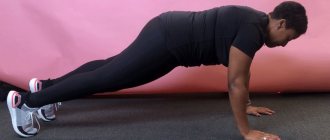Very soon you will become a mother - we can congratulate you on the most important event in your life! Have you ever thought about how you can combine business with pleasure without giving up your previous hobbies? In this case we are talking about sports. I can give you some valuable advice on which workouts are safe for your health (and which are not), help you decide on the choice of fitness direction, and also tell you about cardio and strength exercises that need to be performed during pregnancy.
“Many active women are surprised by how pregnancy affects their exercise routine,” says Renee M. Jeffreys, Ph.D., a prenatal fitness specialist in Milford, Connecticut, and co-author of Preparing for Childbirth. "(publisher: Hartley & Marks). “Be calm and treat it as a natural, short-term change.”
Should you cut back on your cardio? Are certain exercise equipment really contraindicated? Can you continue doing Pilates? The answers to these questions largely depend on what level of athletic training you have, what trimester of pregnancy you are in, and how you feel. However, the fact that the gym is an ideal place for pregnant women is beyond any doubt. If you are uncomfortable doing some cardio equipment or doing an anaerobic exercise makes you uncomfortable, simply change the machine or exercise.
Going to the gym requires a lot of motivation, but believe me, it's worth it and will come back to you in spades. Systematic physical activity during pregnancy relieves pain and prevents constipation, improves sleep and reduces the risk of gestational diabetes (diabetes during pregnancy) and depression. Moreover, through exercise, contractions may become shorter and more painless. Exercising during pregnancy will help you recover faster after childbirth and get back into shape.
It doesn’t matter how or what system you exercise—whether it’s group classes, cardio exercises, or strength training—everything changes during pregnancy. We offer you some tips on how to adapt to these types of changes.
Benefits of Elliptical Training During Pregnancy
Physical activity for pregnant women should be simple and non-traumatic. The ellipsoid fully meets these requirements. Its advantages over other simulators are:
- Toning effect on muscles, without stress on the cardiovascular system.
- There are no bouncing movements that injure the leg joints and spine.
- During pregnancy, the ellipsoid strengthens the back muscles, which helps prevent hernias and pain after childbirth.
- It improves blood circulation in the pelvic organs and reduces pressure on them.
- Using an elliptical trainer reduces the risk of developing varicose veins.
- It works as a preventative for leg cramps. Relieves tension and swelling.
- Exercise helps improve overall health.
- A pregnant woman's resistance to stressful situations increases.
Five water aerobics exercises
When exercising in water, the effect of gravity is reduced, so the load on the joints and spine is significantly reduced. A pregnant woman does not feel the heaviness of her body; an enlarged belly does not interfere with movements, which become easy and smooth. In water you can perform exercises that are impossible on land, which allows you to relax and relieve tension from the muscles that normally bear additional body weight. Perhaps water aerobics is the most enjoyable way to combat swelling and back pain. By the way, swimming in the pool has far fewer contraindications than land sports.
Exercise 1 - Cannonball
To perform this exercise you will need a special rubber stick , which in aqua fitness is called a nudol (from the English word noodle) or simply noodle. Swim to the middle of the pool so that your feet do not touch the floor. Place the noodle behind your back, holding its ends with your hands (as shown in the photo). Stretch your legs as if trying to reach the floor with them. Then, bending your knees, pull them towards your chest. Freeze for two seconds, then straighten your legs. Repeat the exercise 20 times.
Exercise 2 - Breathing.
Active noisy inhalations over the water with a sharp exhalation into the water.
- Inhale above the water and exhale very long into the water. The longer the pregnancy, the longer a person can usually exhale.
- Forced breathing for 10 seconds with an emphasis on inhalation. Smooth inhalation and exhalation.
- Forced breathing for 10 seconds with emphasis on exhalation.
- Imitation of holding your breath while pushing . This exercise must be done after theoretical preparation. Inhale noisily, hold your breath until the 15th count, slowly exhale into the water, inhale again, etc. 3 times. Imitation of 3 attempts during a contraction.
- Variants of the previous exercise, but holding the breath half-exhaled, fully exhaled and closed the glottis.
Exercise 3 - Active at the side.
- Stand with your back to the side. Swing your leg in front of you at the surface of the water.
- Stand with your back to the side. The leg is straightened in front of you. Toe of the foot towards you, away from you.
- Stand with your back to the side. The leg is straightened in front of you. We twist the leg at the hip joint inward and outward.
- Standing with your left side to the side. Straighten your right leg to the side. Straight leg circles forward, backward.
- Standing with your left side to the side. Bend your right leg at the knee and grab it with your right hand by the knee. Turn your knee forward and down with your hand and return it back. "Chicken wing."
- Standing with your left side to the side. Bend your right leg at the knee and grab it with your right hand by the knee. Rotate the knee with your hand so that the right hip joint works . Back and forth.
- Standing with your left side to the side. Bend your right leg at the knee and grab it with your right hand by the knee. Turn your entire body to the side to the left while standing on a stationary leg, then turn back. Without releasing your knee, bend your body to the right, trying to place your right ear on your right knee.
- Standing with your left side to the side. Bend your right leg at the knee and grab it with your right hand by the knee. Stand for a few seconds, trying to keep your body straight and “opening” yourself with your hand behind your knee while exhaling long.
Exercise 4 - Stretches while hanging on the side facing it.
- Hang on the side or handrail by your hands. Bend both legs at the knees, straighten your toes and press your knees against the wall , spreading them as far apart as possible. Put your socks together. Using springy movements, try to press your pelvis to your toes.
- I.p. Same. The pelvis is motionless. Straighten your elbows and bend them.
- Hang on the side or handrail by your hands . Bend your knees and place your feet on the wall as high as possible. Straighten your legs at the knees, making a “float”. Round your back. Then bend your knees, pressing your buttocks against the wall and your heels.
- Hang on the side or handrail by your hands . Bend your knees and place your feet against the wall as wide as possible. Lunge left and right along the wall, bending your legs alternately.
How to use an elliptical during pregnancy
You need to exercise on an ellipsoid, following simple rules:
- Always hold on to the machine when ascending and descending.
- Throughout the entire workout, you must not let go of the handles.
- Keep your back straight, movements are easy.
- During class, breathing should not be interrupted; if it becomes difficult to speak, then the pace must be urgently reduced. Inhale on a simple element, and exhale on tension.
- You can train every day, but it’s better 2-3 times a week, taking breaks. The muscles will have time to recover. Overwork during an interesting situation is harmful.
- Drink as much plain, still water as possible.
- Wear light clothing made from natural fabrics. Too tight and narrow disrupts the body temperature and causes overheating. This negatively affects the well-being of a pregnant woman.
- Heart rate during exercise: no higher than 140 beats per minute. Walking speed: no more than 5 km/h.
- The room should be well ventilated.
Is it possible for pregnant women to exercise?
In most cases, physical activity is even necessary for expectant mothers. Exercising for pregnant women will help you minimize the risk of developing:
- severe toxicosis;
- late gestosis;
- hemorrhoids before and after childbirth;
- varicose veins and thrombosis;
- insufficient oxygen access to the fetus;
- hypoxia during labor;
- perineal ruptures;
- swelling.
It is prohibited to engage in sports during pregnancy if:
- Previously, you had miscarriages, the fetus died.
- You are pregnant with several children at the same time.
- The doctor suspects any complication.
- You did not become pregnant naturally, but through IVF.
If you are in doubt about whether you can exercise during pregnancy, just listen to your body. Women who previously led an active lifestyle are recommended to reduce their load by half. If you weren’t into sports when planning your pregnancy, then start exercising smoothly and consult your doctor first. Each period of gestation has its own recommendations and restrictions regarding the type of sport.
Go to the swimming pool
Swimming during pregnancy is allowed from the moment the mucus plug forms (from the 13th week) until it comes out. This is good for the spine, joints, and swimming also relieves back pain. Pregnant women who visit the pool train their respiratory system, relax well and gain less excess weight. Swimming on the back and butterfly style is prohibited.
Download the press
If you are thinking about what kind of sports you can do while pregnant, then don’t even think about this exercise. Pumping up your abs is dangerous; it can result in pregnancy failure at any stage. If you want to stay in good shape after giving birth, then it is better to sign up for gymnastics for pregnant women: the trainer will select exercises for you that will not harm the baby.
Run
This sport helps stimulate the heart and control weight. However, not all types of running are beneficial for pregnant women. In the first trimester, it is better to refuse exercise, and in the second, only light jogging is allowed for no more than half an hour a day. In the third, you need to start walking. Don't start running if you didn't do it before pregnancy. Wear a bandage and compression garments during your workout. After it, lie down for a quarter of an hour with your legs raised up.
Play bowling
This activity is good because the load alternates with constant rest. You can play bowling if there are no contraindications and you are feeling well, only in the second trimester. Take balls no heavier than 2.5 kg, do not move too sharply. During pregnancy, the ligamentous apparatus becomes more elastic, so the risk of injury increases.
In the gym
It is not recommended to visit the fitness center in the first trimester and 8-9 months. The rest of the time, you are allowed to exercise no more than three times a week. Try to choose cardio equipment, on which you will be able to monitor changes in your heart rate. It will be useful for you to exercise on an exercise bike. It is desirable that it has a back. Any exercise equipment for sedentary exercises, quiet walking on a treadmill or elliptical will do.
Pilates
If you do not know whether you can engage in such sports during pregnancy, consult your doctor first. Experts recommend doing Pilates with a trainer for pregnant women for half an hour every other day, taking into account the main point - the condition of the expectant mother. Abdominal exercises, holding your breath, sudden movements, and shoulder stands should be excluded. You can't lie down on your stomach. Move slowly and smoothly, do not become overtired.
We suggest you read: Why hematogen is contraindicated during pregnancy
Exercises for the 1st trimester, aimed at breathing training with minimal stress:
- walking;
- tilts left, right;
- deflections back and forth;
- exercises for the feet (rotation, standing on toes, heels).
Exercises for the 2nd trimester, when physical activity will benefit both mother and child:
- turns the head and body;
- arm exercises to strengthen the chest muscles;
- bending forward while sitting on the floor with legs spread wide.
In the 3rd trimester, focus on exercises with a fitball:
- swinging to the sides while sitting on the ball;
- squeezing the fitball with your hands;
- body rotations.
If you are not just waiting for your baby to be born, but also want to continue to live actively, watch the following videos. They have selected sets of exercises for each trimester of pregnancy that will be safe for both you and the baby. Watch the videos and you will see that expecting a baby is not a reason to categorically refuse sports activities.
The first step is a consultation with your OB/GYN. Only he, having weighed all the pros and cons, can competently answer this question.
In this case, the main thing is to remember that the first 12 weeks of pregnancy are the most dangerous from the point of view of abortion, so exercises should be very gentle. Starting from the 7th month of pregnancy, it is better to refuse to exercise in the gym, because... any, even the most insignificant, power loads at this stage become unsafe and can lead to undesirable consequences, including premature birth. There are also contraindications that are common to all expectant mothers, regardless of the stage of pregnancy.
Warm up before training
Light stretching is a must before walking on the elliptical trainer. This reduces the risk of injury. The stretch is performed as follows:
- Sitting on the floor, spread your legs in different directions as far as possible.
- Hands reach for toes, slowly leaning forward.
- Next, bend to the sides, gradually helping with your hands.
You should start your workout with a short warm-up:
- For the first 5 minutes you need to move without tension.
- Next, increase the resistance and perform the exercises for 3 minutes.
- Then reduce the load to the original level. Continue this way for another 5 minutes.
- Then slowly increase the resistance to the desired parameters.
Recommendations for home cardio training
Such exercises should be performed two to three times during the week. Schedule days for yourself, this will force you to mobilize and regulate time for other things.
- It is better to start your workout by walking slowly in place for 10 minutes.
- The next part, the main one, is the load on the muscles using light dumbbells, lasts about 40 minutes. The average number of exercises is 10. Exercises should be selected here to work the muscles of the body: back, pectoral, calf, triceps and others. With an average load and intensity of movements, you need to repeat 10 times. In between approaches (from 1 to 3), be sure to rest.
- In the third period of training, abdominal exercises. They can be done from a lying position on your back, on your side or standing. The exercises last no more than 20 minutes. The movements are smooth and breathing control is required. You should do only two sets of 10 repetitions. For pregnant women, the abdominal muscles are especially important, so abdominal exercises are necessary.
- It is better to finish your workout with slow cardio walking or stretching, which should last no more than 10 minutes.
But, remember that the best option for training during pregnancy is the one that is carried out under the watchful eye of a competent trainer or doctor.
What else can you read on this topic:
- How to remove belly fat
- Cardio exercises for weight loss at home
- Remove fat at home
- L-carnitine
- How to remove fat
- Cardio program to burn fat
- Cardio running on a treadmill
- Circuit training to burn fat for women
- Superset training
- L-arginine for women and girls
Characteristics of elliptical trainers
When choosing equipment, it is necessary to take into account some nuances. The convenience and effectiveness of classes will depend on the operating principle and set of functions.
Types of ellipsoids
Based on the principle of operation, there are three types of simulators:
- Mechanical ellipsoids . These are simple and cheap devices. They work by tensioning and loosening a belt on the flywheel. It is necessary to brake due to the efforts of the practitioner. This is a serious disadvantage if a woman needs to stop urgently. In addition, it is quite loud.
- Magnetic trainer . The principle of operation is to move the flywheel closer and further away from the magnet. Often there is a built-in computer. The load is set manually.
- Electromagnetic elliptical trainer . This is the most modern device. But it costs much more than the first two. Braking is carried out by an electric motor; just press a button on the on-board computer. (More about the electromagnetic elliptical trainer)
Below are several models of electromagnetic ellipsoids and their prices.
Basic parameters of the simulator
Leading ellipsoid manufacturers offer different features:
- Exercise machines can be stationary or folding, on wheels. This is convenient for storage in small spaces.
- Very comfortable mobile and stationary handles. The first allow you to work the muscles of the upper body. And stationary ones provide support during training.
- The elliptical for pregnant women can have an adjustable pedal angle. This allows you to increase or decrease the intensity of the load.
- The on-board computer shows the pulse, the number of calories burned, the activity time, and the level of difficulty. The woman chooses the training program herself.
Warnings
Before you start exercising, you should consult your doctor!
You need to discuss with him how safe it is to exercise on exercise machines and whether there are any contraindications. Only after consultation with a specialist are you allowed to go to the fitness club. Although it is better to get such a simulator at home. It doesn't take up too much space, plus it will come in handy after pregnancy to restore and maintain shape. The fact is that the gym turns out to be a very traumatic place for pregnant women.
While carrying a child, you should avoid physical activity, which includes:
- jumping;
- impact movements on the joints;
- increased tension, especially in the pelvic area;
- frequent and sudden changes in position.
Doctors insist that you immediately stop using the elliptical trainer and seek medical help if the following signs are observed:
- dizziness and nausea;
- sharp pain in the lower abdomen;
- bloody issues;
- severe shortness of breath.
Contraindications for pregnant women exercising on an ellipsoid
The body of a pregnant woman differs from the usual in many ways. First of all, the joints become very elastic and fragile. All this is due to the synthesis of the hormone relaxin. It is designed to increase the elasticity of the ligaments so that childbirth is easier and less traumatic. It is important to note that the hormone softens all joints and ligaments in the body. Therefore, you need to exercise with extreme caution.
Exercises on an elliptical trainer during pregnancy have contraindications:
- the state of the uterus is in increased tone;
- discharge containing blood;
- pain in the lower abdomen;
- miscarriages or previously frozen pregnancies;
- polyhydramnios;
- toxicosis and gestosis;
- risk of miscarriage;
- cramping sensations after physical activity.









